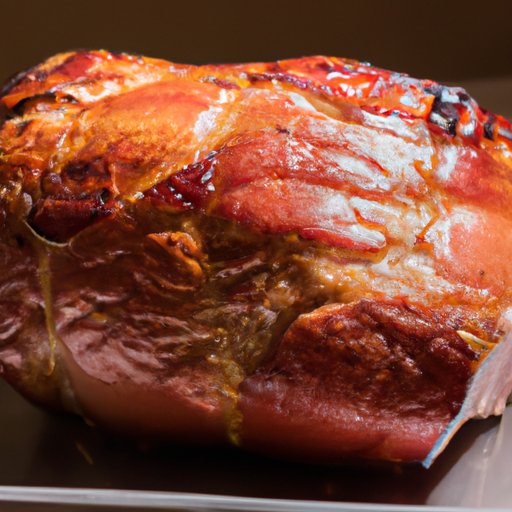
Introduction
If you’re planning a dinner party, a holiday meal, or simply looking for an easy, crowd-pleasing recipe, look no further than baked ham. Cooking a ham in the oven is a simple and delicious way to feed a family or entertain guests. In this article, we will guide you step-by-step through the process of cooking a ham in the oven, with detailed instructions and pictures. We will also discuss recipe adaptations, how to make the recipe healthier, and regional variations that can add variety to your meals.
Step-by-Step Guide with Pictures
Before you start cooking your ham, make sure you have the necessary ingredients and equipment. You will need:
– 1 (8 to 10-pound) fully-cooked bone-in ham
– 1 cup brown sugar
– 1/2 cup honey
– 1/2 cup Dijon mustard
– 1/4 cup apple cider vinegar
– 1/4 cup orange juice
– 1/4 cup water
– 1 tablespoon Worcestershire sauce
– 1 teaspoon garlic powder
– 1 teaspoon onion powder
You will also need an oven-safe roasting pan, aluminum foil, and a meat thermometer.
1. Preheat the oven to 325 degrees F.
2. Remove the ham from its packaging and rinse it with cold water. Pat it dry with paper towels.
3. Score the skin in a diagonal pattern and place it in the roasting pan with the cut side down.
4. In a small saucepan, combine the brown sugar, honey, mustard, vinegar, orange juice, water, Worcestershire sauce, garlic powder, and onion powder. Cook over medium heat until the sugar has dissolved and the sauce has thickened slightly.
5. Brush the sauce over the ham, making sure to get it between the slices if the ham is sliced.
6. Cover the roasting pan with foil and bake for 2 to 2 1/2 hours, or until the internal temperature reaches 140 degrees F.
7. Remove the foil and increase the oven temperature to 400 degrees F.
8. Brush the ham with the remaining sauce and bake for an additional 10-15 minutes, or until the skin is crispy and caramelized.
9. Remove from the oven, tent it with foil, and let it rest for 15-20 minutes before carving.
Video Tutorial
For those who prefer a visual guide, we have created a video tutorial to accompany this recipe. Our video tutorial covers the entire recipe, from preparation to serving, and includes tips and suggestions for adapting the recipe to personal preferences. The tutorial includes a combination of visual and audio elements, making it an engaging and informative resource for any aspiring home cook.
Recipe Adaptations
Whether you’re looking to add some spice, cut down on sugar, or change up the flavors, there are many ways to adapt a traditional ham recipe to your liking. Here are a few tips:
– For a spicier glaze, add some red pepper flakes or cayenne pepper to the sauce.
– To reduce sugar, use a sugar substitute like Stevia or Splenda in place of brown sugar or honey.
– For a different flavor, use alternative ingredients like maple syrup, balsamic vinegar, or soy sauce in place of the honey, vinegar, or Worcestershire sauce.
– To make it more savory, add some herbs like thyme, rosemary, or sage to the sauce.
Health-Focused Article
If you have health goals in mind but still want to enjoy baked ham, there are some tips to make this recipe more nutritious. Some suggestions are:
– Choose a ham that is free-range and organic, with no added chemicals or preservatives.
– Make a homemade sauce with natural sweeteners like agave nectar or maple syrup instead of brown sugar or honey.
– Add some vegetables to the roasting pan, such as carrots, potatoes, or onions, to increase fiber and nutrients.
– Use a meat thermometer to make sure the internal temperature of the ham reaches 140 degrees F, which is safe for consumption.
Regional Variations
There are many different ways to cook ham around the world, each with its own unique flavor and method. Some popular regional variations include:
– Southern-style ham: A brown sugar glaze is combined with mustard and spices to create a sweet and tangy flavor. The ham is then placed in a roasting pan with a mixture of orange juice and coke, which creates a caramelized crust.
– Italian ham: Prosciutto is a popular Italian ham that is air-dried and aged for several months. It is often served thinly sliced as an appetizer or added to pasta dishes for a salty, savory flavor.
– Spanish ham: Jamón Iberico is a type of cured ham from Spain made from the Iberian pig. It is often served thinly sliced as a tapa and has a rich, nutty flavor.
Conclusion
Cooking a ham in the oven is a simple and delicious way to feed a family or entertain guests. In this article, we have provided a comprehensive guide to cooking ham in the oven, accompanied by pictures and a video tutorial. We have also discussed recipe adaptations, ways to make the recipe healthier, and regional variations that can add variety to your meals. We hope this guide inspires you to try different variations of the classic ham recipe and experiment with different flavors and ingredients.




